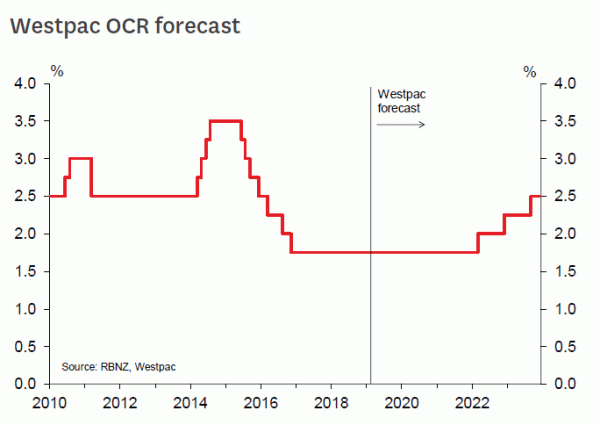- The RBNZ is likely to repeat the key messages from February, including “OCR on hold through 2019 and 2020” and “the next move could be up or down.”
- The details of the statement will also be similar to February, emphasising global risks and a positive domestic outlook.
- Recent developments have been in line with RBNZ expectations, so there is no reason for the RBNZ to change stance.
- The impending move to a Monetary Policy Committee is another reason for the RBNZ to avoid rocking the boat right now.
- Markets would be surprised by an unchanged statement from the RBNZ. Swap rates and the exchange rate would rise a bit.
The RBNZ is unlikely to alter its firmly-on-hold stance at next week’s March OCR Review. Recent data has been mixed, and hasn’t created any strong basis for shifting the OCR outlook one way or the other.
At the February Monetary Policy Statement, the RBNZ said it expects to keep the OCR unchanged “through 2019 and 2020” and that “the next move in the OCR could be up or down.” This was a dovish shift from late-2018, when the “up or down” statement had been omitted, and the OCR was expected to remain at 1.75% only “into 2020”, not throughout that year.
The main reason for the RBNZ’s dovish tilt at the time was concern about the global economic outlook, which was weakening. The RBNZ’s take on the domestic economy was upbeat – it emphasised that capacity pressures were emerging, that the economy was expected to pick up in 2019 on the back of fiscal stimulus, and that core inflation was expected to rise.
The RBNZ is unlikely to have altered its views since February, given that economic developments since that time have been mixed.
A few elements of the domestic economy have been weaker than the RBNZ anticipated. Weak house sales data recently might cause the RBNZ to lower its house price forecast a bit, and GDP in the December quarter was a touch weaker than the RBNZ’s February forecast. But overall, the RBNZ can still credibly stick to the view that the economy is set to pick up this year, especially in light of very strong consumer spending and building consent numbers coming through recently.
Global central banks, including the US Federal Reserve, have continued to shift to more dovish stances in acknowledgement of a gradual but broad-based slowdown in global economic growth. But this global economic situation is probably in line with the RBNZ’s expectations from February, rather than being any kind of surprise. Actually global prices for New Zealand’s key export commodities, including dairy, have been stronger than expected in recent weeks. So from a New Zealand point of view, international trading conditions have improved since February.
Finally, the exchange rate has been trading very close to the RBNZ’s previous forecast, again creating no strong reason for the RBNZ to alter its stance.
Given the mixed nature of recent economic developments, we would expect the Reserve Bank to issue a statement very similar to the February press release, repeating the key phrases: “We expect to keep the OCR at [1.75%] through 2019 and 2020” and “The direction of our next OCR move could be up or down.” The details will continue to emphasise global risks but to talk up the chances of New Zealand’s economy picking up, including citing the risk that inflation in New Zealand picks up more than expected. There might be some slight acknowledgement that the domestic economy has weakened a bit, but that would be decidedly second-order.
The impending change to the monetary policy decision making structure is another reason to expect a steady-asshe- goes approach from the Reserve Bank. The fact that a committee is about to take over probably creates a higher hurdle for the Governor to take decisive action on the OCR outlook right now – after all, the committee could take a different approach to the current leadership.
We expect the membership of the RBNZ’s new Monetary Policy Committee to be announced a few days after the March OCR Review. The four RBNZ members are likely to be Governor Adrian Orr, Deputy Governor Geoff Bascand, Assistant Governor Christian Hawkesby, and the new Chief Economist who is yet to be appointed. There will also be three external members.
Financial markets are primed for something more dovish than we anticipate. Many global central banks have shifted to a more dovish stance recently. Financial markets probably believe that the Reserve Bank is going to follow suit. If the RBNZ actually issues a vanilla statement without much change, as we expect, then swap rates and the exchange rate would rise on the day.













